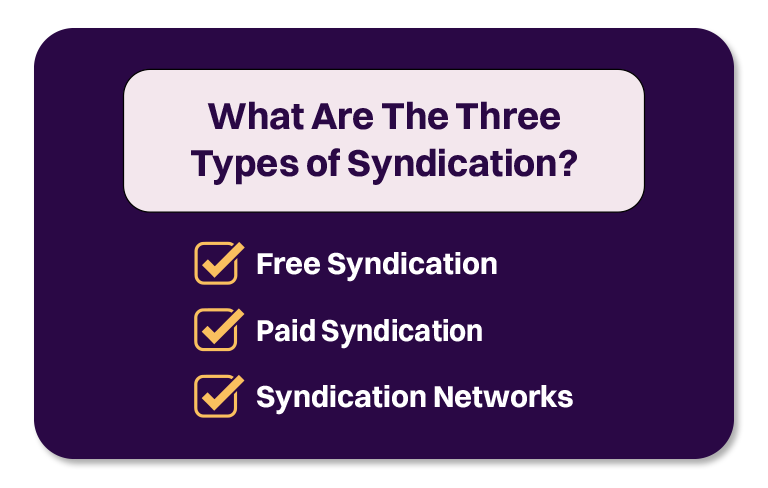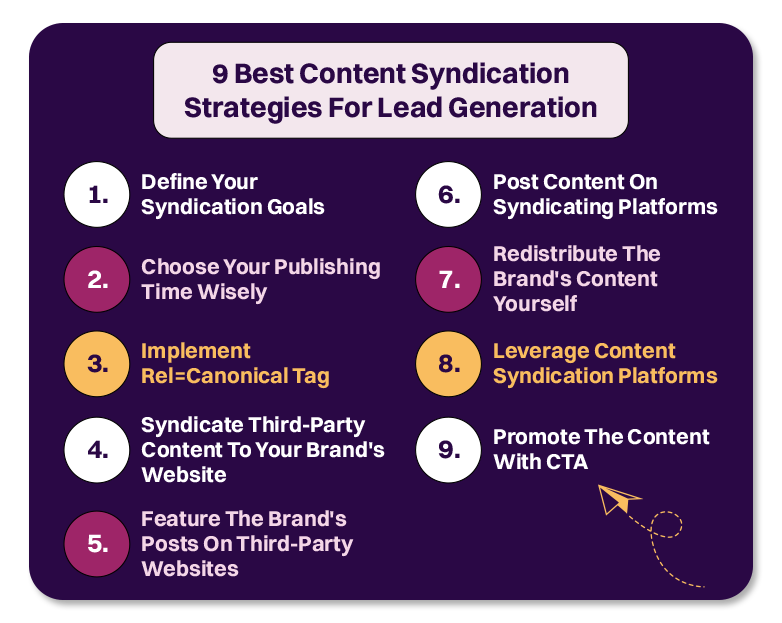
How to Use Content Syndication to Generate Intent-Based MQLs
Your content strategy isn't just any plan; it's about finding the right way to conduct your content marketing. It involves crafting gems of information that resonate with your audience. But, the magic truly happens when your masterpiece lands in the hands of the perfect crowd.
This is where effective distribution channels, like content syndication, play an important role. But what exactly is content syndication, and how it’s vital for your content marketing? Are there any strategies you should be aware of while using content syndication?
This article delves into these aspects of a content syndication campaign to help you successfully define your business content.
What Is Content Syndication?
Content syndication is a strategic approach to republishing your content via 3rd parties. It applies to your digital content (Whitepapers, blogs, infographics, videos, eBooks, etc.).
Here, you’ll approach the audience of established platforms relevant to your business. Thus, you’ll quickly reach your potential customers.
You can syndicate high-value content like white papers, e-books, or industry reports to third-party websites.
These platforms, in turn, often gate this content, asking their users for some form of contact information to access the full content. For example, their email address. Once users provide their information, they become your leads that our sales team can follow up on. Basically, these users will become your marketing-qualified leads (MQLs).
As with all marketing efforts, clear goals must guide content syndication. So, let's now discuss the goals of content syndication.
What Is The Goal Of Content Syndication?

Depending on the specific needs of your business, the content syndication goals can differ. However, this approach serves several common objectives that yours and other businesses relate to. These are as follows:
Increased Brand Awareness
Content syndication exposes your brand to loyal audiences of 3rd party websites. Getting your content in front of larger audiences increases brand recognition and visibility.
More Website Traffic
Always link back your syndicated content with your website. This way, readers finding your content valuable or interesting can reach your website.
High-Value Leads
Syndication helps in utilizing content to grow leads. When you show your thought leadership through your content, you attract leads who want to learn more. These types of readers providing their contact information in exchange for information are likely to move into your sales funnel.
Improved SEO Ranking
Backlinks from syndicated content can help improve your site's SEO ranking. However, use canonical tags to ensure search engines identify your website as the original content source.
Establish Authority
Publishing your content on reputable, well-established websites gets your content in front of new audiences. It helps position your brand as an authority in your industry. Plus, putting your content alongside other high-quality articles automatically lends credibility to your brand and range.
Now, let us move ahead to various types of content syndication you can leverage.
What Are The Three Types Of Syndication?

Though there are three main types of content syndication, you can choose several methods depending on your:
- Content type
- Target audience
- Overall goals
Now, let’s check the three types of content syndication:
Free Syndication
This is the most straightforward method for allowing other sites to republish your content for free. It's beneficial in gaining visibility and driving traffic back to your site.
Paid Syndication
Here, you pay to feature your content on popular websites. This method can significantly boost your content’s visibility and reach, enhancing brand awareness and potentially driving more traffic or leads. It's a way for marketing content syndication efforts.
Syndication Networks
In this method, you join a website network that regularly shares and publishes each other's content. It is mutually beneficial and can rapidly expand your content’s reach to diverse audiences. That's why many businesses consider content syndication for lead generation too.
Understanding With An Example
Imagine running a SaaS business and having just developed an insightful white paper on the advantages of using specific software for business workflow management. You understand the power of content syndication and leverage it to enhance your reach and generate leads. Here's how you can approach this using different types of syndication:
- Free Syndication: You can offer this white paper for free republication to technology-focused blogs or digital media outlets. Doing this increases your brand's visibility and awareness amongst a larger or different audience.
- Paid Syndication: To reach an even broader audience, consider paying for your white paper to be featured on high-traffic technology news websites. This could lead to increased readership and significant traffic back to your site.
- Syndication Networks: You could also consider joining a network where businesses regularly share and republish each other's content. Becoming part of a SaaS-focused content syndication network could help you reach a highly relevant audience.
In each scenario, you'd align with your marketing goals - increasing brand awareness, driving website traffic, generating leads, improving SEO ranking, or establishing industry authority. Each type of content syndication can be tailored to help achieve these goals, depending on how it's executed. This approach will not only disseminate your valuable content but also enhance the potential for lead generation and brand recognition.
But in the end, all you need is proper content syndication strategies for lead generation.
9 Best Content Syndication Strategies For Lead Generation

Content Marketing Institute says 65% of B2B marketers use content syndication in their content marketing strategy. So, ignoring this marketing tactic doesn’t seem wise.
In fact, to help you, we already curated nine effective strategies to benefit from content syndication. Let’s see to each of them:
1. Define Your Syndication Goals
Before you start syndicating your content, defining what you hope to achieve is essential. Are you looking to increase brand awareness, generate leads, drive traffic to your website, or all of these? By setting clear goals, you can better assess the success of your syndication strategy and make necessary adjustments.
You can do this by:- Identify the primary objective of your syndication efforts (e.g., brand awareness, lead generation).
- Set measurable goals (e.g., a specific number of leads to generate or traffic increase percentage).
- Review these goals regularly and adjust your strategy as needed.
2. Choose Your Publishing Time Wisely
When you syndicate, your content can significantly impact its success. If you publish and syndicate content on your site simultaneously, the syndicated version may achieve higher visibility. This is largely due to the greater traffic and established authority of the syndicating website.
Some of the things you can do while selecting the publishing time are as follows:- Publish your content on your website before syndicating it.
- Wait for search engines to index the content on your site.
- Then, proceed with syndicating your content to other sites.
3. Implement Rel=Canonical Tag
Canonical links are crucial for the success of your content syndication strategy. The rel=canonical tag informs search engines that the content on your site is the original version. Even if this content is republished elsewhere on the web, the rel=canonical tag helps prevent SEO issues related to duplicate content and ensures that search engines credit your site as the source.
Implementing the rel=canonical tag properly will help safeguard your site's SEO while reaping the benefits of content syndication. You can do this as follows:
- Use the rel=canonical tag for each piece of content you syndicate. This tag should point to the content on your site.
- Confirm with your syndication partners that they're implementing the tag correctly.
- Periodically audit your syndicated content to verify that the rel=canonical tags are in place and functioning as expected.
4. Syndicate Third-Party Content To Your Brand's Website
To provide additional value and fresh perspectives to your audience, consider syndicating relevant content from third-party sources to your website. This B2B content distribution strategy diversifies your content pool and fosters strong industry relationships. Thus, you become a part of a healthy exchange of knowledge.
When you are going for third-party content, try following these things:
- Identify high-quality, relevant third-party content.
- Secure permission for syndicating the chosen content.
- Accurately credit original authors and sources.
Suppose you run a blog that focuses on digital marketing strategies. You can syndicate an article from a renowned digital marketing expert or an authoritative source like 'Marketing Land' or 'HubSpot' on your blog. Ensure that you have proper permissions and provide appropriate credit. This introduces your audience to expert insights and varied perspectives.
5. Feature The Brand's Posts On Third-Party Websites
Amplify your content's exposure by featuring your brand's posts on third-party websites. This strategy can help to significantly broaden your reach and draw substantial traffic back to your site. It could be achieved through guest posting, partnerships, or paying syndication. It's an excellent way of enhancing your brand's visibility among a wider or different audience.
Some of the things that you can adopt are as follows:- Pinpoint third-party websites with a substantial and relevant audience.
- Initiate relationships with these websites to feature your content.
- Ensure your content aligns with the third-party site's audience and tone.
6. Post Content On Syndicating Platforms
You can increase your content's reach by leveraging syndication platforms such as Medium, Reddit, or LinkedIn. These platforms house a diverse range of content, attracting different audience segments. By syndicating your content here, you can tap into their extensive user base. Hence, it creates additional touchpoints for potential customers and enhances your brand's visibility.
Here is how you can achieve this:
- Identify syndication platforms popular among your target audience.
- Adapt your content to suit each platform's unique formatting, style, and user preferences.
- Engage with readers' comments or feedback to foster community and boost your brand's reputation.
- Tailor your content slightly to suit each platform's unique audience and formatting requirements.
7. Redistribute The Brand's Content Yourself
Take charge of distributing your own content. You only need to be present at platforms like social media or industry-specific forums.
When planning to redistribute the content, try following these tips:- Identify appropriate platforms for redistribution.
- Repurpose your content to match the unique necessities of each platform.
- Monitor user engagement to identify which content forms and platforms resonate best with your audience.
8. Leverage Content Syndication Platforms
Use content syndication platforms to distribute your content to a larger audience. Platforms, like Outbrain or Taboola, can help drive traffic to your site. They host a vast array of content. Thus, they can position your brand in front of audiences to discover your brand.
To find the best B2B content syndication platforms, follow these tips:- Explore various content syndication platforms and identify those that align with your target audience.
- Understand the cost structure and potential ROI of these platforms.
- Experiment with different content types on these platforms to identify what generates the best engagement.
Suppose you've produced a data-driven report on 'Consumer Behavior Trends in Online Shopping.' You could leverage a platform like Outbrain to promote this report, ensuring it's seen by a wide, interested audience. Platforms like these strategically place your content where it's likely to generate interest and engagement.
9. Promote The Content With CTA
Promote syndicated content with clear and compelling calls-to-action (CTAs) that guide readers to your site. Whether the goal is to encourage them to read more, sign up for a newsletter, or check out your products or services, effective CTAs are a critical component of successful content syndication.
To promote the content with the CTA, here is what you need to do:- Ensure each piece of syndicated content includes a clear and compelling CTA.
- Incorporate a direct link back to your website within the CTA.
- Monitor click-through rates to gauge the effectiveness of your CTAs and adjust as necessary.
- Ready to transform your B2B SaaS strategies? Schedule a personalized consultation with our team and discover the power of our strategies today.
- Don't miss out on the opportunity to supercharge your CRM system. Request a demo of our cutting-edge CRM tool today.
- Take the next step and start improving your outbound lead generation today! Download our comprehensive guide for actionable tips and strategies.
Implementing these strategies can help your brand leverage content syndication effectively for enhanced visibility and lead generation. Also, check out our guide on how to measure content syndication, to refine your efforts.
Conclusion
You're not just sharing your content; you're unleashing a foolproof way that puts your brand into the limelight. We're talking about supercharging your SEO rankings, bringing more traffic and making you a thought leader. Plus, your message not just reaches your usual crowd – it goes to a wider audience.
Conducting content syndication can be complex. But, it becomes seamless with one of the dedicated content syndication vendors like Revnew.
As a profound lead generation agency, Revnew masters the art of syndication, ensuring your content gets the right exposure and reaches potential customers effectively. Their tailored approach ensures maximum impact and results, making content syndication a compelling part of your marketing strategy.
Trust in Revnew's expertise to unlock the full potential of your content marketing endeavors.
FAQs
1. Is content syndication paid media?
Content syndication can be both a paid and unpaid media strategy. Paid syndication involves partnering with other websites or platforms to promote and distribute your content, usually for a fee. On the other hand, unpaid syndication is when others share your content due to its value without any monetary exchange. The choice between paid and unpaid largely depends on your objectives, budget, and content value.
2. Is syndication bad for SEO?
Content syndication, when done correctly, is not bad for SEO. It can help improve your SEO by increasing your online presence and providing backlinks to your site. However, it's important to manage it properly to avoid issues like duplicate content, which can harm your rankings. To ensure SEO friendliness, you can use techniques like the canonical tag, which tells search engines the source of the content.
3. Is content syndication legal?
Yes, content syndication is legal as long as it's done with the permission of the original content creator. Unauthorized syndication can lead to copyright infringement issues. Therefore, it's critical to obtain explicit permission from the original author or publisher before syndicating content. Additionally, it's considered good practice to attribute the content to its source to maintain transparency and respect copyright laws.




